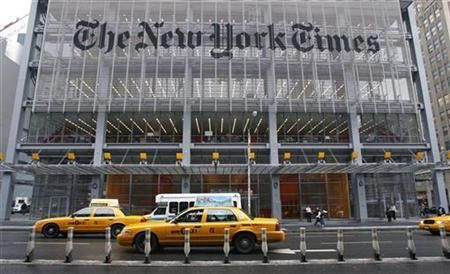Will The New York Times End Its Print Edition? Netscape Founder Says It’s Time

At the International News Summit two years ago, Arthur Sulzberger Jr., chairman of the New York Times Company (NYSE: NYT), acknowledged that the future of the newspaper business, and the Times itself, is digital. “We will stop printing the New York Times sometime in the future,” he told attendees.
It was not a prediction, but rather a tongue-in-cheek response to a question about the future of the paper’s print edition. Sulzberger made the comment just a few months before the Times enacted its metered paywall, and he was likely feeling giddy over the prospect of a fresh revenue stream, one that represented the future and not the past. But aside from his comments fueling a brief surge of analysis and speculation from media pundits, chatter about the notion of paperless New York Times has largely been dormant since.
Until Wednesday, that is, when a prominent Silicon Valley venture capitalist revived the discussion at the New York Times DealBook Conference. Marc Andreessen, co-founder of the pioneering browser company Netscape, said he believes the Times Co. should shut down its print edition “as soon as possible,” Reuters reports. Responding to a question about the Times’ future, Andreessen acknowledged that print media can still be profitable and that there will always be people who love print newspapers. However, he added that facing the realities of transformative technology requires going “on 100 percent offense.”
But should Sulzberger really take his advice? While two years ago, the idea might have seemed hypothetical enough for the Times chief to joke about, today it seems much less so. Consider the company’s dismal third-quarter earnings, posted in late October. Earnings were off 85 percent from the previous year, largely due to what one analyst, according to Forbes, called “shockingly weak” advertising revenue.
That’s a bold statement, considering that print revenue has been falling since the onset of the recession in 2008. For any stock analyst to be shocked by just how much it fell during the most recent quarter speaks volumes about how difficult things really are at the Times. (That difficulty was underscored earlier this month when the company announced that it is shrinking its newsroom by 30 employees -- the third such reduction since 2008.) And while the aforementioned paywall has helped boost subscription revenue 7 percent for the quarter, expecting it to solve the company’s ad-revenue hemorrhaging is like trying to patch a broken water main with a Band-Aid.
Of course, the Times is not alone in this struggle. According to the Newspaper Association of America, revenue across the entire industry fell 5.1 percent during the third quarter. Perhaps even more disconcerting is that this is the 25th straight quarter of ad revenue decline. The NAA reports that total ad revenue today is $49.3 billion, less than half of what it was in 2006. As Digiday’s Josh Sternberg pointed out last month, Google (Nasdaq: GOOG) now generates more ad revenue than the entire newspaper industry.
If and when the Times does make the jump to end its daily print edition, it will be in good company. The New Orleans Times-Picayune, the Seattle Post-Intelligencer, the Rocky Mountain News of Denver and the Ann Arbor (Mich.) News are just a few newspapers that have either cut their frequency or gone all-digital. And in October, the Telegraph reported that the storied U.K. paper the Guardian is “seriously discussing” an end to its print edition after almost two centuries in print. The Guardian quickly shot down that rumor, calling it “wholly inaccurate.” But among its higher ups -- and among those at the Times and elsewhere -- it’s hard to imagine that such serious discussions are not actually taking place. If not today, soon.
© Copyright IBTimes 2024. All rights reserved.






















